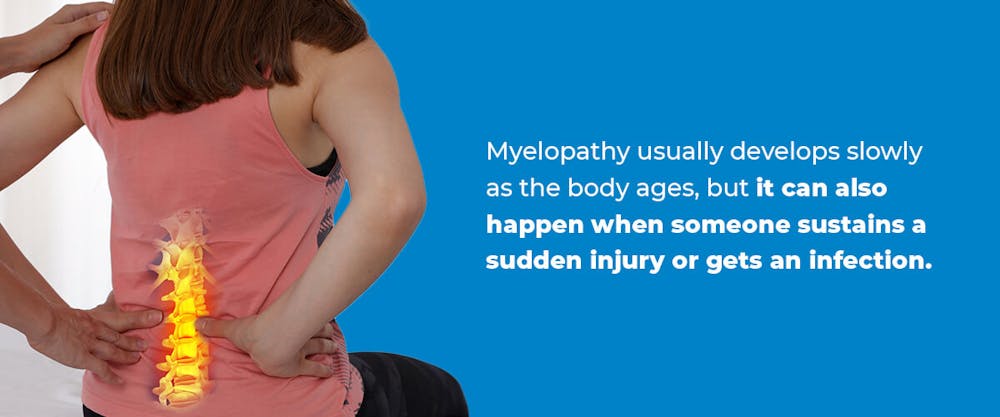Myelopathy is a condition that affects an individual’s spine and can cause unpleasant symptoms that diminish their overall quality of life. If you or someone you care about has been diagnosed with myelopathy, you may be looking for answers. Here you will learn more about myelopathy, including possible treatment options.
Myelopathy Explained
Myelopathy is a condition that occurs when the spine becomes severely compressed. When the spinal cord is under pressure, it can’t function properly, leading to pain, numbness or trouble moving certain body parts.
The spine surrounds the spinal cord — a bundle of nerves that transfer messages between the brain and body. Usually, the spinal bones shield the spinal cord, keeping it from getting compressed. However, serious injury to the spine, tumors, arthritis, herniated discs and infections can create enough tension to impact or harm the spinal cord.
What Are the Types of Myelopathy?
The area of the spinal injury determines the type of myelopathy an individual has. There are three types:
- Cervical myelopathy: Cervical myelopathy arises when someone had compression in the neck, known as the cervical spine.
- Thoracic myelopathy: Myelopathy that develops in the middle section of the spine is known as thoracic myelopathy.
- Lumbar myelopathy: The lower back is called the lumbar spine. When myelopathy affects this region, it’s known as lumbar myelopathy.
What are the Signs and Symptoms of Myelopathy?
When the spinal cord is damaged or under pressure, an individual may experience a loss of function or sensation as well as pain or discomfort in the area at or below the point of injury. Exact symptoms depend on the type of myelopathy the person has.
Cervical Myelopathy Symptoms
An injury in the cervical spine may cause:
- Pain and stiffness in the neck
- Decreased range of motion
- Weakness in the arms or hands
- Tingling or numbness in the arms or hands
- Clumsiness and reduced coordination of the hands
- Trouble handling small items, like coins or pens
- Difficulty with balance
As cervical myelopathy worsens, you may feel a shooting pain that starts in the neck and travels down the spine.
Thoracic Myelopathy Symptoms
An injury in the thoracic spine may cause:
- Reduced coordination
- Pain or discomfort in the neck, arm, lower back or leg
- Weakness, numbness or tingling
- Trouble walking
- Difficulty maintaining balance
- Trouble controlling the bladder or bowels
- Difficulty with fine motor skills like tying shoelaces or writing with a pen
Lumbar Myelopathy Symptoms
An injury in the lumbar spine may cause:
- Pain and weakness in the lower back
- Loss of balance
- A change in gait
- Diminished dexterity
- Inability to control the bladder or bowels
- Sexual dysfunction
What Causes Myelopathy?

Myelopathy usually develops slowly as the body ages, but it can also happen when someone sustains a sudden injury or gets an infection. Other causes of myelopathy include:
- Spinal stenosis: Spinal stenosis is a degenerative spinal condition in which the space inside the backbone becomes too small and compresses the spinal cord.
- Herniated discs: A herniated disc occurs when one of the spongy spinal discs that separate the vertebrae slips out and protrudes into the spinal canal. These bulging discs can put pressure on the spinal cord and lead to myelopathy.
- Rheumatoid arthritis: Rheumatoid arthritis (RA) is an autoimmune disorder that causes the body to attack its own tissues. RA can affect the cervical spine, causing inflammation that may compress the spinal cord and lead to myelopathy.
- Spinal tumors, cysts, hematomas and hernias: These conditions can put pressure on the spinal cord and lead to myelopathy.
- Radiation therapy: Radiation can treat cancerous tumors in the body. Sometimes, however, radiation can damage the surrounding tissues. If radiation therapy is used to treat a spinal tumor, it may potentially harm the spinal cord and lead to myelopathy.
How is Myelopathy Diagnosed?
A doctor will perform a thorough exam and may use the following tests to help determine a myelopathy diagnosis:
- X-ray: An x-ray can help rule out other conditions.
- MRI: An MRI provides a detailed view of the spine.
- Myelography: A myelogram is an exam that uses a contrast dye and imaging to reveal problems in the spinal canal.
- Electromyogram or evoked potentials: These nerve function tests measure the electrical activity in the nerves and muscles.
How is Myelopathy Managed and Treated?
Myelopathy is treated based on the underlying cause. If the cause is irreversible, treatment focuses on helping relieve symptoms and slowing the progression of the disorder.
Nonsurgical Treatment Options
Conservative treatments for myelopathy may help ease pain and discomfort. Sometimes nonsurgical treatments work well enough that patients can avoid surgery or at least put it off until it becomes necessary.
The following types of conservative treatments are particularly helpful when the cause of the myelopathy is related to inflammation:
- Pain medication: Over-the-counter painkillers such as acetaminophen and ibuprofen can help treat side effects associated with mild myelopathy. A doctor may prescribe pain medication for more severe cases.
- Steroid injections: Cortisone is a steroid that can be injected into the spine to reduce swelling.
- Physical therapy: Poor posture can lead to weakness in the back and neck muscles. When these muscles become weak, the spine can more easily slump over and compress the spinal cord. Physical therapy may help by reconditioning the neck and back muscles. A physical therapist can also demonstrate how to modify activities and avoid certain movements that cause pain and discomfort.
Surgical Treatment Options
Doctors may recommend surgery in moderate to severe cases of myelopathy or if conservative options have not been helpful. Surgery for myelopathy aims to eliminate pressure on the spinal cord and create more space in the spinal canal.
Surgeries for myelopathy include:
- Anterior cervical discectomy and fusion: In this surgery, the entire injured disc is removed through the front of the neck. The two vertebrae are then connected to keep the spine stable.
- Posterior cervical decompression/microdiscectomy: This surgery is performed when only part of the affected disc needs to be removed. The damaged section of the disc can be removed through the back if it’s too close to the spinal cord.
- Posterior cervical foraminotomy: If a herniated disc or bone spur narrows the spinal column, it may be possible for a surgeon to go through the back of the neck to remove part of the injured disc or break off the bone spur.
- Spinal decompression: This procedure is helpful in cases where the spinal cord is compressed by swelling or bone spurs. The surgeon may remove parts of — or the entire — vertebra to relieve the problem.
- Anterior cervical corpectomy: This surgery removes the bone at the front of a vertebra plus the discs above and below it. The bones are then combined into one solid segment.
- Posterior cervical laminectomy: This procedure removes a part of the spine, called the lamina, to give the spinal cord more space.
Trust Your Spinal Concerns to the NYSI
The New York Spine Institute is a multi-specialty spine and orthopedic center serving New York City and beyond. If you live with chronic pain due to myelopathy, our compassionate team of health care professionals is ready to care for you. Schedule an appointment today to start your journey to the quality of life you deserve.

